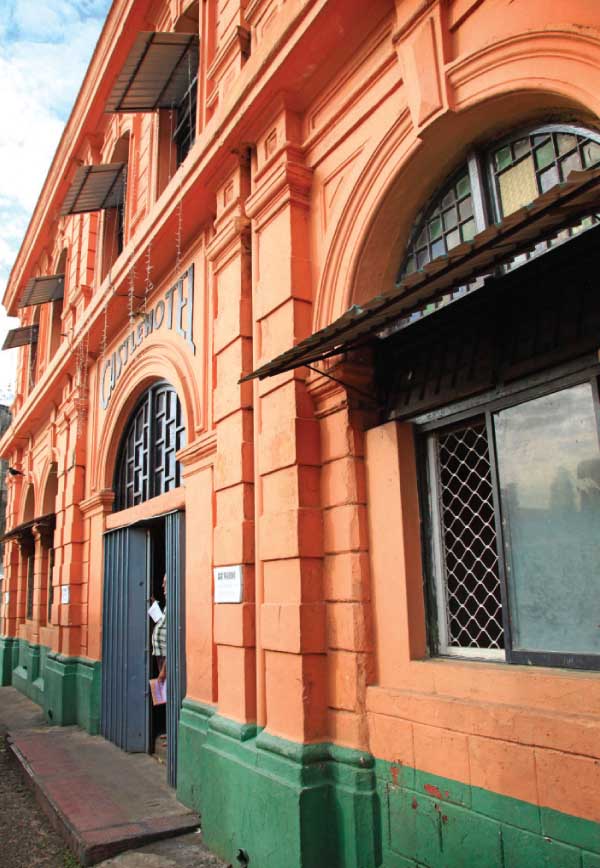By Dr. Lopamudra Maitra Bajpai
As a train whistles out of Kompannavidiya Railway Station in Colombo 2, it passes by a road in its immediate vicinity- where traditional, colonial and contemporary public spaces stand next to each other as silent sentinels connecting history with modernity.
It is the Justice Akbar Mawatha, stretching from Kompannavidiya Railway Station on the one side to the confluence of Malay Street and Church Street on the other.
A changing landscape and a fast-altering public-space have transformed the architectural character of this road, and highlights the need to understand the many things wrought by the passage of time.
On this road stands a landmark – the Cave building. Though in a dilapidated condition at present, a close study of this building and the history and oral traditions surrounding it, reveal much about the socio-economic life of the people residing here during British rule, especially the coffee trade.
As one end of the road ends with the railway station, and the other end at the mouth of Malay Street- which stretches next to the Defense Services College marked by its high walls.
Even an exceptionally warm afternoon will not reduce the traffic and noise which are characteristic of Justice Akbar Mawatha. Still referred to with by its Dutch colonial name the “Slave Island” the road occupies a central location and today stands as an important representation of history with the old and the new existing cheek by jowl. But modernity is taking over the life and landscape of Slave Island with elan. New constructions stand tall as several older ones are getting reduced to rubble.
On the right pavement, stands the Cave building. Famous as one of the oldest buildings in the area, the building is named after Henry W. Cave, the British officer who was instrumental in starting the railways in Ceylon in 1865.

With Britain officially declaring the abolition of slavery in 1833, the Dutch colonial terminology “Slave Island” was not preferred by the successor British colonial administration. The Twentieth Century Impressions of Ceylon (1st published in 1907) edited by Arnold Wright says: “South-eastwards from the Fort boundary and bordering the lake on the western side lies the quarter of the city known as the Slave Island. This ugly un-British appellation perpetuates the memory of the days when under Dutch rule, household slavery prevailed, and the native menials were confined at night to this part of the city….all such relics of those ‘good old days’ have along ago disappeared from the neighborhood, only the name of the district remaining to preserve from well-merited oblivion the memories of a benighted past…..”
The book further says that “Slave Island is now both a residential and business quarter” and mentions an immediate need to replenish the area with “‘better buildings and commercial constructions, wider roads, erection of better type of dwellings for the lower classes and the provision for proper drainage.”
Thus, Slave Island saw massive reconstruction under British rule. This was coupled with the introduction of the railways and the construction of the railway station on the same road. Cave building bore testimony to many of these changes. Local lore helps us reconstruct the history of the place.
The backyard of the massive building was used to dry coffee. Coffee beans were brought by the British from the Central Highlands to Colombo port for export by the railway. Coffee trade gave the road its name- Kompannavidiya or Company Road.

The two-storied Cave building is massive and stretches all along Justice Akbar Mawatha. Today it houses different commercial enterprises.Several eateries coexist commercial ventures of different types including Ceylon Dry Cleaners started in 1934. The architecture of the massive building resembles the many colonial structures across South Asia which were built to suit similar climatic conditions.
Built with commercial activities in mind, the main focus was on facilitating air-flow in an age when there was no air-conditioning to keep the rooms cool. The windows had shutters, which were closed at night, but the windows were left open during the day to allow sufficient air-flow into the rooms. All the vents are angled away from the rooms- so that even if there is a cloud-burst, rain water will not enter the buildings.
Cave building’s windows are in a dilapidated condition though restructured several times. But the vents remain. Often in British commercial complexes, the houses of the merchants used to be on the second floor. Possibly the top floor also housed merchants once upon a time.
Following similar colonial buildings around South Asia, the entrances of the shops were built about two yards away. This enabled a protective colonnade to be included in the design. This provided cover to customers during heavy rains and the summer heat.
At present, the entrances of the shops on the ground floor of Cave building leaves little space for pedestrians as modern doors are fitted at the entrance-line. However the architecture inside is colonial.
The 1878 Kompannavidiya Railway Station, also known as Slave Island Railway Station, is located 1.78 km away from Colombo Fort. Ceylon Cold Stores and old warehouses are in its immediate exterior. With the typical cast-iron corrugated roofs of the British colonial era, the Kompannavidiya railway station is a quaint structure. The wide verandah at the entrance allowed airflow to give a cooling effect.
(The featured image at the top is that of the Kompannavidiya Railway Station, a quaint little railway station of the colonial era)
Author Dr. Lopamudra Maitra BajpaI is a visual anthropologist, specialising in history, intangible cultural heritages and popular culture.



























































